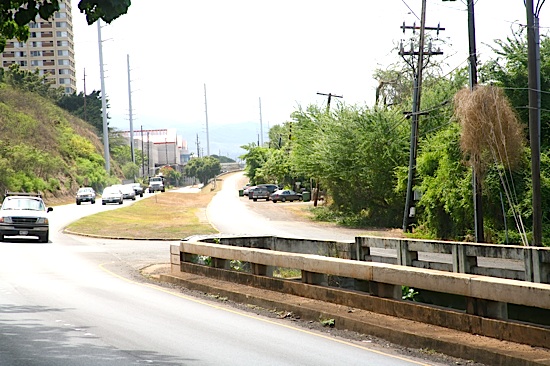Banana Patch properties picked for rail facilities, families must relocate
Emilio Farinas has lived in his home on the Waiawa Banana Patch for 12 years. His family's home is one of 10 located on the area selected for a Park-and-Ride facility as part of the Honolulu Rail Transit plan.
Honolulu Rail Transit officials have plans to acquire ten Pearl City residences whose lands will be used as a future depot.
Pending federal and state approval of the project’s Environmental Impact Statement (EIS), which is slated for submission in October, the properties will be converted into a Park-and-Ride: a facility that allows drivers to park at the station and then take public transit to their destinations.
The properties—comprised of 10 homes along with a church and a trucking company’s storage facility—are situated south of Sam’s Club near Leeward Community College in an area known as the Waiawa Banana Patch.
According to officials, because the area is bound by several major arteries of traffic flow, including the freeways and the Farrington and Kamehameha Highways, it’s the most sensible place to have the Park-and-Ride. The location and facility are meant to be convenient for commuters driving from Central Oahu since there will be a special off-ramp from the H-2 Freeway going directly to the station.
“It’s the most ideal location for it,” said Scott Ishikawa, a spokesman for the project. “It’s ideal for the people coming from Mililani and Wahiawa ... those kinds of areas that won’t have direct rail service.”
According to Cruz Vina, Transportation Chair for the Pearl City Neighborhood Board, before the Banana Patch properties were earmarked, alternative Park-and-Ride locations were meticulously considered. One was near the Century Park Plaza Condominiums (also known by residents as the Twin Towers) just west of Sam’s Club, but it was determined to be too cost prohibitive. Another plan would have situated the station closer to Leeward Community College, but it would have reduced the number of stalls available for the school.
“It just works out that the Banana Patch properties would cause the least amount of harm to the overall community,” said Vina. “It’s just practical.”

The City and County notified the affected property owners and tenants of the likely acquisition last summer and will be working with them on relocation. Bounded by federal law, the government is required to provide housing support, including rental assistance for tenants and fair market compensation for landowners.
“There are specific obligations we have to fulfill,” Ishikawa said, “And they’re pretty comprehensive.”
One of the landowners, Emilio Farinas, has lived here with his family of eleven for 12 years. He’s retired, and the family grows papaya, squash, and assorted vegetables to sell at the state open markets for supplemental income.
“I’m retired,” he said, “so I don’t want to work hard to find a new place ... I’m too old already.”
“We love this place,” said his wife.
Another landowner, Sam Alipio, has lived at the Banana Patch for over 60 years, and four generations of his family currently reside on the agricultural property. He said that despite being sad about the acquisition, there isn’t much he can do to stop the City from invoking Eminent Domain: the right of the government to seize an owner’s property.
“They have the upper hand,” he said. “But as long as they compensate me fairly, I’m okay with it. I don’t want to make any waves.”
The proposed 1700-parking stall site is one of five Park-and-Ride facilities which will be stationed throughout the initial 20-mile route that runs from Kapolei to Ala Moana. Project officials expect the governor and the Federal Transit Administration to approve the EIS in time to begin alignment work in the area sometime next year. The properties comprise ten of the 20 residential units and at least 62 businesses being affected by the project.